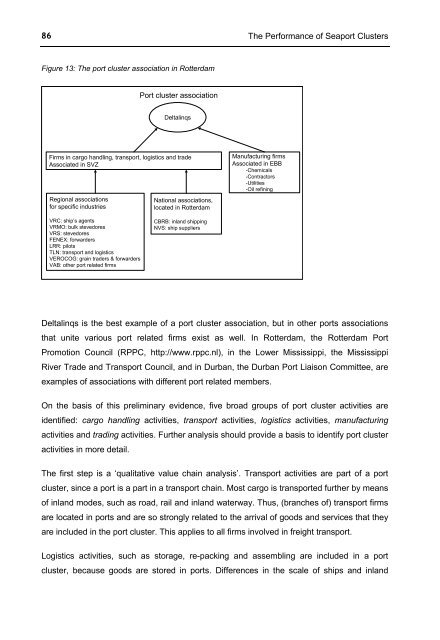The Performance of Seaport Clusters - RePub - Erasmus Universiteit ...
The Performance of Seaport Clusters - RePub - Erasmus Universiteit ...
The Performance of Seaport Clusters - RePub - Erasmus Universiteit ...
You also want an ePaper? Increase the reach of your titles
YUMPU automatically turns print PDFs into web optimized ePapers that Google loves.
86<br />
Figure 13: <strong>The</strong> port cluster association in Rotterdam<br />
Port cluster association<br />
Deltalinqs<br />
Firms in cargo handling, transport, logistics and trade<br />
Associated in SVZ<br />
Regional associations<br />
for specific industries<br />
VRC: ship’s agents<br />
VRMO: bulk stevedores<br />
VRS: stevedores<br />
FENEX: forwarders<br />
LRR: pilots<br />
TLN: transport and logistics<br />
VEROCOG: grain traders & forwarders<br />
VAB: other port related firms<br />
National associations,<br />
located in Rotterdam<br />
CBRB: inland shipping<br />
NVS: ship suppliers<br />
<strong>The</strong> <strong>Performance</strong> <strong>of</strong> <strong>Seaport</strong> <strong>Clusters</strong><br />
Manufacturing firms<br />
Associated in EBB<br />
-Chemicals<br />
-Contractors<br />
-Utilities<br />
-Oil refining<br />
Deltalinqs is the best example <strong>of</strong> a port cluster association, but in other ports associations<br />
that unite various port related firms exist as well. In Rotterdam, the Rotterdam Port<br />
Promotion Council (RPPC, http://www.rppc.nl), in the Lower Mississippi, the Mississippi<br />
River Trade and Transport Council, and in Durban, the Durban Port Liaison Committee, are<br />
examples <strong>of</strong> associations with different port related members.<br />
On the basis <strong>of</strong> this preliminary evidence, five broad groups <strong>of</strong> port cluster activities are<br />
identified: cargo handling activities, transport activities, logistics activities, manufacturing<br />
activities and trading activities. Further analysis should provide a basis to identify port cluster<br />
activities in more detail.<br />
<strong>The</strong> first step is a ‘qualitative value chain analysis’. Transport activities are part <strong>of</strong> a port<br />
cluster, since a port is a part in a transport chain. Most cargo is transported further by means<br />
<strong>of</strong> inland modes, such as road, rail and inland waterway. Thus, (branches <strong>of</strong>) transport firms<br />
are located in ports and are so strongly related to the arrival <strong>of</strong> goods and services that they<br />
are included in the port cluster. This applies to all firms involved in freight transport.<br />
Logistics activities, such as storage, re-packing and assembling are included in a port<br />
cluster, because goods are stored in ports. Differences in the scale <strong>of</strong> ships and inland

















